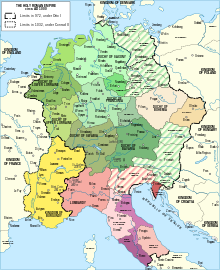
A stem duchy (German: Stammesherzogtum, from Stamm, meaning "tribe", in reference to the Franks, Saxons, Bavarians and Swabians) was a constituent duchy of the Kingdom of Germany at the time of the extinction of the Carolingian dynasty (death of Louis the Child in 911) and through the transitional period leading to the formation of the Ottonian Empire. The Carolingians had dissolved the original tribal duchies of the Empire in the 8th century. As the Carolingian Empire declined, the old tribal areas assumed new identities. The five stem duchies (sometimes also called "younger stem duchies" in contrast to the pre-Carolingian tribal duchies) were Bavaria, Franconia, Lotharingia (Lorraine), Saxony and Swabia (Alemannia).[1] The Salian emperors (reigned 1027–1125) retained the stem duchies as the major divisions of Germany, but the stem duchies became increasingly obsolete during the early high-medieval period under the Hohenstaufen, and Frederick Barbarossa finally abolished them in 1180 in favour of more numerous territorial duchies.
The term Stammesherzogtum as used in German historiography dates to the mid-19th century, and from the beginning was closely related to the question of national unification. The term's applicability, and the nature of the stem duchies in medieval Germany, consequently have a long history of controversy. The overly literal or etymologizing English translation "stem duchy" was coined in the early 20th century.[2] While later authors tend to clarify the term by using the alternative translation "tribal", use of the term "stem duchies" has become conventional.[3]
- ^ See Donald C. Jackman, The Konradiner: A Study in Genealogical Methodology, 1990, p. 87, citing Hans-Werner Guetz, "Dux" und "Ducatus." Begriffs- und verfassungsgeschichtliche Untersuchungen zur Enstehung des sogenannten "jüngeren Stammesherzogtums" an der Wende vom neunten zum zehnten Jahrhundert, 1977.
- ^ Ephraim Emerton, Mediaeval Europe (814–1300), 1903; "Revival of the Roman Empire on a German Basis, 888–950" pp. 89–114; Emerton uses English stem in its archaic sense of "stock, race, ancestry" (Webster's (1828): "a race or generation of progenitors"; Oxford Dictionaries: "(archaic or literary) The main line of descent of a family or nation"). "We may fairly think of the German kingdom under Henry I as a federation of five distinct stems, each far more conscious of its stem-unity than of its share in the unity of the nation" (p. 105); "All five stems were represented [at the election of Conrad II in 1024] by their leading men, not yet, so far as we know, by any well-defined process of representation, but only in pursuance of the ancient Germanic principle that every man who carried a sword had a right to speak on matters of the public weal." (p. 175)
- ^ "Germany consisted in 911 of the five tribal, or, as the Germans call them, 'stem' (Stamm), duchies of Saxony, Franconia, Bavaria, Swabia, and Lorraine. [...] The people of the various 'stem' duchies showed characteristic traits also in culture and language. And though the tribal duchies had lost their political role in German history by the thirteenth century and had been replaced by other and usually smaller regional units, their tribal dialects and folklore have survived to the present day and even now act as strong forces toward cultural diversity. In this respect, 'Teutonic' Germany has had a thousand years of historical unity." Hajo Holborn, A History of Modern Germany: The Reformation, 1982, p. 4.